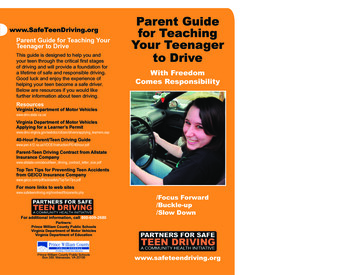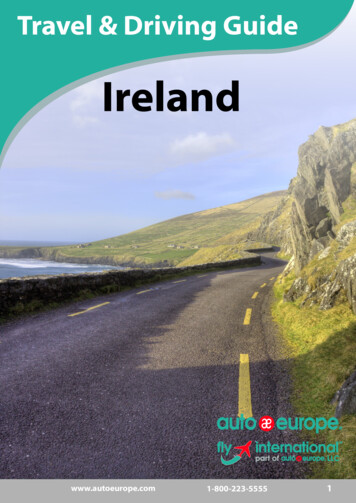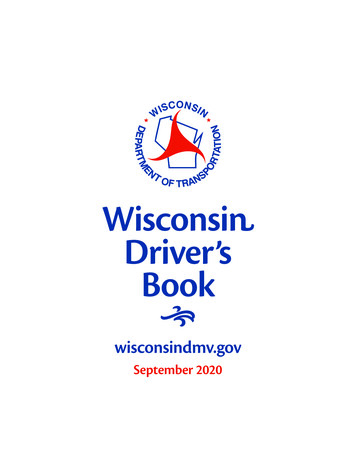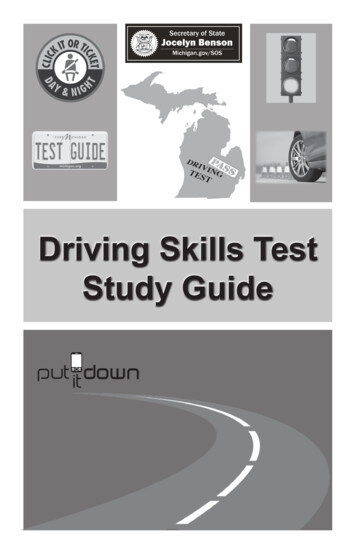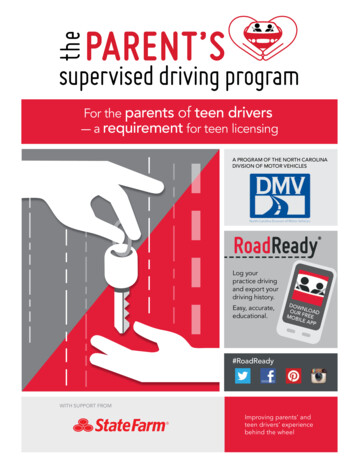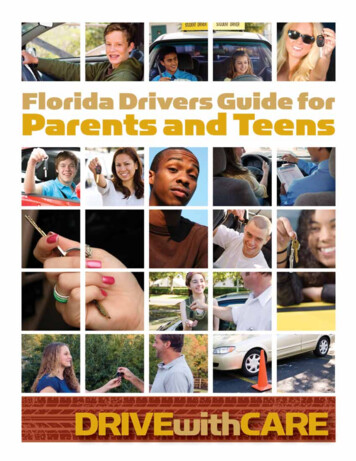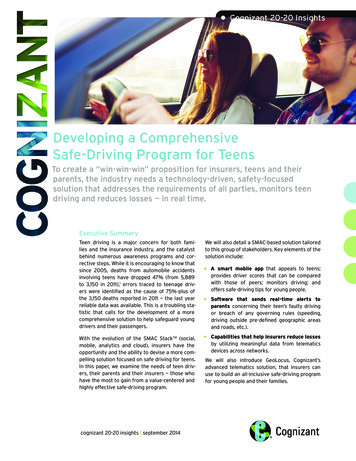
Transcription
Cognizant 20-20 InsightsDeveloping a ComprehensiveSafe-Driving Program for TeensTo create a “win-win-win” proposition for insurers, teens and theirparents, the industry needs a technology-driven, safety-focusedsolution that addresses the requirements of all parties, monitors teendriving and reduces losses — in real time.Executive SummaryTeen driving is a major concern for both families and the insurance industry, and the catalystbehind numerous awareness programs and corrective steps. While it is encouraging to know thatsince 2005, deaths from automobile accidentsinvolving teens have dropped 47% (from 5,889to 3,150 in 2011),1 errors traced to teenage drivers were identified as the cause of 75%-plus ofthe 3,150 deaths reported in 2011 — the last yearreliable data was available. This is a troubling statistic that calls for the development of a morecomprehensive solution to help safeguard youngdrivers and their passengers.With the evolution of the SMAC StackTM (social,mobile, analytics and cloud), insurers have theopportunity and the ability to devise a more compelling solution focused on safe driving for teens.In this paper, we examine the needs of teen drivers, their parents and their insurers — those whohave the most to gain from a value-centered andhighly effective safe-driving program.cognizant 20-20 insights september 2014We will also detail a SMAC-based solution tailoredto this group of stakeholders. Key elements of thesolution include: A smart mobile app that appeals to teens;provides driver scores that can be comparedwith those of peers; monitors driving; andoffers safe-driving tips for young people. Software that sends real-time alerts toparents concerning their teen’s faulty drivingor breach of any governing rules (speeding,driving outside pre-defined geographic areasand roads, etc.). Capabilities that help insurers reduce lossesby utilizing meaningful data from telematicsdevices across networks.We will also introduce GeoLocus, Cognizant’sadvanced telematics solution, that insurers canuse to build an all-inclusive safe-driving programfor young people and their families.
The Need for Teen SafetySounding the AlarmYoung men and women (ages 16 through 19) constitute one in 20 motorists; yet they cause onein seven vehicle accidents. These statistics underscore the importance of designing safe-drivingprograms tailored to teens. Additional researchreinforces this critical need: Motor vehicle crashes are the leading causeof death for U.S. teens; in 2010, seven teensages 16 to 19 died every day from motor vehicleinjuries.2 Per mile driven, teen drivers are three timesmore likely than drivers 20 and older to beinvolved in a fatal crash.3 In 2010, 22% of drivers between 15 and 20years old who were involved in fatal motorvehicle crashes were drinking.4 In 2011, only 54% of high-school studentsreported that they always wear seat belts whenriding with someone else.4 More than 1,000 young drivers lose their liveseach year in vehicle crashes because of animpaired driver (i.e., either from their owndriving or someone else’s).5 Teens are involved in vehicle accidentsprimarily because they are inexperienced — notnecessarily because they take more risks thanolder drivers.Leading Causes of Teen-Driver AccidentsThe findings we have cited demonstrate the magnitude of the problem: The majority of teens’ livesare at risk due to their driving behavior. This isespecially true when it comes to newly licenseddrivers, teens driving with teen passengers,and male teens (accident rates are almost doublethose of female teens) who are more prone torisk-taking. Year over year, numbers show thatteen safety is a clear and serious societal concern. Research confirms that the leading cause ofaccidents involving young drivers can be tracedto one or a combination of the following factors: Lack of awareness of the consequences of riskybehavior. Inexperience with the complexities of driving. Impaired driving due to road conditions,including driving at night. Reckless driving, including speeding.The Ineffectiveness of Existing ProgramsWhile there are many methods and programsfor improving teens’ driving behavior, most haveproven ineffective. The reasons?Most involve one-time/shorter periods of training — either before a license is granted or aftera driving incident occurs. Also, teens’ participation in this type of program is focused on grantingthem a driver’s license, not at motivating them tobecome and remain a safe driver.Moreover, the effectiveness and reach of a program depends on the stringency and applicationof specific laws in the area where incidents takeplace and where the teen lives.Most teens tend to drive oldervehicles, which lack sophisticated safety features. And last,but not least, young peoples’decision-making capabilitiesdo not fully develop until theyreach their mid-twenties.Teens are wellaware of the risksand consequencesof unsafe driving.However, theytend to overlookthe consequences.These facts send a clear message that new approaches andtechniques are required to facilitate safer teendriving. These should include: A broader view, from multiple dimensions (notjust teens alone). Advanced technology to support/extend safetycoverage. Provisions for continually monitoring thesuccess of the solution. The use of psychological techniques to helpimprove the effectiveness of the program.Peers in the vehicle with the teen driver.Distraction caused by cell phones.Viewing driving as a social activity.cognizant 20-20 insightsDriving under the influence of alcohol or otherdrugs.2
A Better Approach to TeenSafety ProgramsIdeally, a successful safety program for teendriving should motivate teens to participate;be sensitive to parents’/guardians’ needs; andapply precise data-collection tools and deepdive analytics for insurers to prevent losses andachieve higher profit margins.Enabling Teen ParticipationStudies have revealed that simple peer pressurecan encourage teens to develop risky drivinghabits. Furthermore, research shows that thepresence of other teens in a car being drivenby a teen significantly increases the chances ofa motor-vehicle accident — whether or not thepassengers are explicitly urging the driver tomake unsafe driving decisions/traffic maneuvers.Additional findings confirm that a teen’s ability to react to a situation may be lacking whencompared to adult drivers. Teens are well awareof the risks and consequences of unsafe driving.However, they tend to overlook the consequences.Many existing programs provide teens with information and instructions about safe driving, butfall short when it comes to addressing the underlying attitudes that influence how they drive.Moreover, many programs do not offer a way togauge teen driving habits. A comprehensive program should: Encourage teens to enroll.Sustain continuous adoption.Support/reward safe driving.Measure driving behavior.A solution thatinforms a parentabout how their teenis driving and sendsalerts if they aredriving recklesslyand/or breakingrules can offer peaceof mind and keeptheir child out ofharm’s way.For teens, social factors — frompeer pressure to showing offbehind the wheel, to racingand speeding — are major contributors to unsafe driving. Webelieve that employing socialmedia to encourage safe driving can be a more familiarand acceptable way to reachout to teen drivers.Also, teens’ use of smartphonesis on the rise; statistics suggestthat about 70% of individualsbetween the ages of 16 and 19use these devices,6 which have become an indispensable part of their day-to-day lives.cognizant 20-20 insightsKeeping this in mind, smartphones are ideal for helpingteens adopt and stick with adriving safety program.Complementing the program with gamificationtechniques that motivateteens to win can keep theminterested and engaged inlearning safe driving habits.A leaderboard that tracksindividuals’ driving skills isa good way to inspire youngdrivers to do their best.A smart mobile appthat appeals toteens, provides driverscores, comparesdriving scoreswith those of otherparticipating teens,gives safe-driving tipsand provides realtime alerts offers acompelling proposition.In our view, a smart mobile app that appeals toteens, provides driver scores, compares drivingscores with those of other participating teens,gives safe-driving tips and provides real-timealerts during dangerous driving offers a compelling proposition.Involving ParentsParents are naturally concerned when their teenis behind the wheel of a vehicle. They want toknow where they are and how they are driving.Nonetheless, parents can be a distraction. In fact,recent research findings confirm that approximately 53% of teens who said they spoke on thephone when behind the wheel were actually communicating with a parent; 46% said they typicallyspoke with a friend.7A good driver-safety program for teens shouldprovide parents with: Ubiquitous access to information.Boundaries and limits to govern teen driving.Real-time monitoring while the teen is behindthe wheel.With the advent of SMAC technology, these threeobjectives can be met — all via a device with asmart app installed in the car or carried by theindividual. The device transmits real-time information about the driver’s location, the speed atwhich they are driving and other vital informationrelated to their behavior behind the wheel. Bigdata analytics tools, such as those from Espertech,a provider of complex event processing (CEP) andanalysis, can process this information in real timeand disseminate it to relevant stakeholders.Working together, these technologies can createa comprehensive monitoring mechanism thatchecks how a teen is driving at any given timeor place. A parent or other designated party can3
set up a “geo fence” and specify the areas inwhich their teen is allowed to drive. They can alsoestablish speed limits. Once this configuration iscompleted, the data coming from the teen’s car ormobile device can be monitored and parents notified of nonconformance. All in real time.For instance, assume that a mother has set up ageo fence that limits her son’s driving to a 15-mileradius around their home. If her son drives beyondthat area, she will immediately receive a text message or e-mail notification.A solution that informs a parent how their teen isdriving and sends alerts if they are driving poorlyand/or breaking rules can offer peace of mind andhelp keep their child out of harm’s way.Supporting the InsurerApart from parents and teens, teen safety is amajor concern for states, many of which have hadsuccess with graduate driving-license programs(GDLs). Numerous non-profit organizations, suchas Brakes for Brett, Lives Interrupted and DriversEdge have also taken up the cause, as have automotive manufacturers and insurers.Insurers stand to benefitby offering teen safety programs that can: Prevent and reduce loss.Corroborate circumstantial data. Leverage telematics datafor predictive analytics. Improve customer satisfaction.The data collectedwill be the biggestasset for theinsurance company.It provides the opticsto prevent loss,predict loss frequency,identify riskierdriving behavior, andsegment dangerousdriving zones.Such a program should beend-to-end, providing theinsurer with the amountand type of data that can becorroborated for the actuarial process, pricingand claims processing. The program must alsosatisfy customers and garner their loyalty, whichcan translate into higher profit margins.The data it collects will be the biggest asset forthe insurance company. It provides the optics toprevent loss, predict loss frequency, identify riskydriving behavior, and segment dangerous drivingzones. Figure 1 below shows how telematics andbig data can help insurers prevent losses.How Telematics Data Can Enhance the Bottom Line Biometric Sensors Internal Data TelematicsMobile Apps TelematicsDevices in Car BIGAGGREGATEDATA Cameras Satellite Data Weather Report Traffic PatternsTelematicsPRInternal,External BigDataAnalyticsCloudFigure 1cognizant 20-20 insights Reward forPreemptive Action Satisfied Customer!4EVENT EVENTSPersonalizedPolicyholderServicesLower LossesIncurred(Predict & Prevent)
A Win-Win-Win Proposition for Insurers, Parents and TeensINSURERPARENTTEENLaunches teensafety program.Enrolls teen.Is encouraged touse the mobile app.Providesid tteen withithsafety portal& mobile apps.Sets up geofence& speed limits forsafe driving.Benefits fromreal-time alerts anddriving tips.Collects drivingbehavior data.Createsnotification rules.Strives to beon top ofleaderboard.Benefits fromsafe driving &reduced losses.Views the portal,compares drivingbehavior.Earns badges& redeems rewardsfor safe driving.Figure 2A Teen Safety ProgramThat Benefits AllA successful teen-safety insurance programshould be viewed as a winning proposition byteens, their parents and insurers.Insurance is meant to indemnify, or compensate,for the financial loss of the insured. On the otherhand, insurance means business to carriers; theymust earn a profit to sustain and grow their company. In personal insurance lines, teen driving isinevitable. At the same time, statistics tell us thatteens are very vulnerable to vehicle crashes, andare considered immature drivers. It is a real challenge for the insurer to reduce and prevent lossand still make a profit.among them. However, offering a teen-safetyprogram as an addendum to a carrier’s personalinsurance policy is one of the best ways to reduce/prevent loss.To do this, carriers should offer parents andteens a solution that helps them set the drivingagreement, make teen enrollment provisions andenable monitoring of teen driving behavior byparents. As a catalyst to gradually improve teendriving behavior, the carrier can also monitorteen driving, provide unbiased feedback to teensand their parents, and reward above-averagedriver performance.Figure 2 illustrates the “win-win-win” value proposition for parents, teens and insurers.In general, there are many ways to reduce or prevent the risks posed by teen driving. Introducingsafety programs, offering discounts for implementing risk-control programs and stipulatingconditions during the issuance of a policy arecognizant 20-20 insights5
GeoLocus At a GlanceTelemetry Data CollectionM2M Communication GatewayGEOLOCUSBIG DATA &TELEMATICS DATADRIVER PORTAL Driving Behavior Teen Safety Features(GeoFence, Leaderboard ) Complex Events Processingfor Real-Time AlertsINSURER PORTAL Insights & Analytics Business Rules & Servicesfor Portals Vehicle Monitoring Driver Risk ScoreINSURER’S CORE APPLICATIONSTelematics UW InputsGeoLocus Smartphone AppOR In-Car Device*UNDERWRITING SYSTEMPolicy DataPOLICY ADMIN SYSTEMCLAIMS SYSTEM* We have partnerships to provide In-Car Device options.Figure 3The Cognizant ApproachCognizant’s GeoLocus is a cost-effective, highlyscalable hosted telematics solution designed tohelp insurers provide more value and increase theirROI. This all-in-one system encompasses devices,software, data management, analytics, portalsand mobile apps (see Figure 3). Furthermore,GeoLocus covers the entire telematics spectrum,including telemetry data collection; a machine-tomachine (M2M) gateway; a telematics platform,and a sophisticated event-processing engine thatprovides real-time analytics. These features canbe leveraged to build specific solutions in areassuch as teen safety or user-based insurance (UBI)programs for insurers and the insured.The GeoLocus mobile app for data collection,along with the insurer portal, complement a teensafety program with capabilities that include: Out-of-the box integration with core insurancesystems (i.e., ACORD-based message and datamodels, and interfaces to other COTs products). Comprehensive features for addressing endto-end needs, starting with data collectionthrough analytics. Smartphone apps that provide a cost-effectiveoption for delivering value-added services suchas teen-safety solutions.cognizant 20-20 insights A scalable architecturethatmeetstime-tomarket challenges; forexample, telematics initiatives like teen safety canbe launched within sixmonths.Looking ForwardGeoLocus covers theentire telematicsspectrum, includingtelemetry datacollection; a machineto-machine (M2M)gateway; a telematicsplatform; and asophisticated eventprocessing engine.Safe driving reduces the possibility of accidents — therebyreducing the number ofinjuries and losses theyinflict. This is especially relevant when it comes to teen drivers — makingit prudent for an insurance company to supporta highly effective, technology-supported teensafety program.Today, using disruptive, market-changing technologies such as telematics, mobility, big-dataanalytics and cloud, insurers are better positioned to offer all-inclusive programs that helppredict and prevent teen-related accidents.By leveraging the SMAC Stack in conjunction witha knowledgeable telematics consulting partnersuch as Cognizant, insurers can devise a scalable and flexible teen safety program designedto prevent accidents, save lives and strengthentheir position in the marketplace.6
References /documents/Mobile-Consumer-Report-2013.pdf 08/distracted-driving-parentsphones/13740087/ https://www.health.ny.gov/prevention/injury prevention/children/fact sheets/teens 15-19 years/teen drivers passenger safety 15-19 years.htm http://teendriving.statefarm.com/system/article downloads/2013 miles to go staticfiles/nti/pdf/811434.pdfFootnotes1Miles to Go – A national teen driver safety report. http://teendriving.statefarm.com/system/article downloads/2013 miles to go report.pdf2Centers for Disease Control and Prevention. Web-based Injury Statistics Query and Reporting System(WISQARS. 2012. National Center for Injury Prevention and Control, Centers for Disease Control andPrevention (producer). [Cited Sept. 28, 2012.].3Insurance Institute for Highway Safety (IIHS). Fatality Facts: Teenagers 2010. Arlington (VA): The Institute.2012. [cited Sept. 28, 2012]. me Teenagers&year 20104National Highway Traffic Safety Administration (NHTSA), Dept. of Transportation (US). Traffic Safety Facts2010: Young Drivers. Washington, D.C.: NHTSA; May, 2012 [cited 2012 Sept. 28].5Dept. of Transportation (U.S.), National Highway Traffic Safety Administration (NHTSA). Traffic SafetyFacts 2010: Alcohol-Impaired Driving. Washington (DC): NHTSA; 2012 [cited 2012 Sept. 28]. Available atURL: http://www-nrd.nhtsa.dot.gov/Pubs/811606.PDF6The Mobile Consumer. /documents/MobileConsumer-Report-2013.pdf7Parents Drive Kids to Distraction. 08/distracteddriving-parents-phones/13740087/About the AuthorsArul Aaron Rajamony is an Associate Director of Projects within Cognizant’s BusinessCloudTM InsuranceSolutions team. He leads the product development team for insurance telematics and P&C claims. Arulhas nearly 15 years of experience in application development, design, architecture and consulting. Hehas focused on insurance product development for the past three years. In that time, he and his teamhave built a comprehensive claims analytics platform, an insurance telematics platform and a claimsadjuster platform. Arul received his bachelor’s degree in Electrical & Electronics Engineering (B.E. EEE)from PSG College of Technology, Coimbatore, India and his master’s degree in e-Business (M.S. e-Biz) fromBirla Institute of Technology, Pilani, India. He can be reached at Arulaaron.Rajamony@cognizant.com.Murali Kandan is a Manager of Projects within Cognizant’s BusinessCloudTM Insurance Solutions team,where he is responsible for product development in insurance telematics and P&C claims. He focuseson product roadmaps and release management and leads the mobile development team. Murali has14 years of experience in application development, with a strong background in various developmentmethodologies – waterfall, IIDM, Scrum Agile and product development. Murali received his Bachelor ofEngineering (BE), Mechanical Engineering degree from SASTRA University, Thanjavur, India. He can bereached at Murali.Kandan@cognizant.com.cognizant 20-20 insights7
About CognizantCognizant (NASDAQ: CTSH) is a leading provider of information technology, consulting, and business process outsourcing services, dedicated to helping the world’s leading companies build stronger businesses. Headquartered inTeaneck, New Jersey (U.S.), Cognizant combines a passion for client satisfaction, technology innovation, deep industryand business process expertise, and a global, collaborative workforce that embodies the future of work. With over 75development and delivery centers worldwide and approximately 187,400 employees as of June 30, 2014, Cognizantis a member of the NASDAQ-100, the S&P 500, the Forbes Global 2000, and the Fortune 500 and is ranked amongthe top performing and fastest growing companies in the world. Visit us online at www.cognizant.com or follow us onTwitter: Cognizant.World HeadquartersEuropean HeadquartersIndia Operations Headquarters500 Frank W. Burr Blvd.Teaneck, NJ 07666 USAPhone: 1 201 801 0233Fax: 1 201 801 0243Toll Free: 1 888 937 3277Email: inquiry@cognizant.com1 Kingdom StreetPaddington CentralLondon W2 6BDPhone: 44 (0) 20 7297 7600Fax: 44 (0) 20 7121 0102Email: infouk@cognizant.com#5/535, Old Mahabalipuram RoadOkkiyam Pettai, ThoraipakkamChennai, 600 096 IndiaPhone: 91 (0) 44 4209 6000Fax: 91 (0) 44 4209 6060Email: inquiryindia@cognizant.com Copyright 2014, Cognizant. All rights reserved. No part of this document may be reproduced, stored in a retrieval system, transmitted in any form or by anymeans, electronic, mechanical, photocopying, recording, or otherwise, without the express written permission from Cognizant. The information contained herein issubject to change without notice. All other trademarks mentioned herein are the property of their respective owners.
highly effective safe-driving program. We will also detail a SMAC-based solution tailored . to this group of stakeholders. Key elements of the solution include: A smart mobile app. that appeals to teens; provides driver scores that can be compared with those of peers; monitors driving; and offers safe-driving tips for young people.

